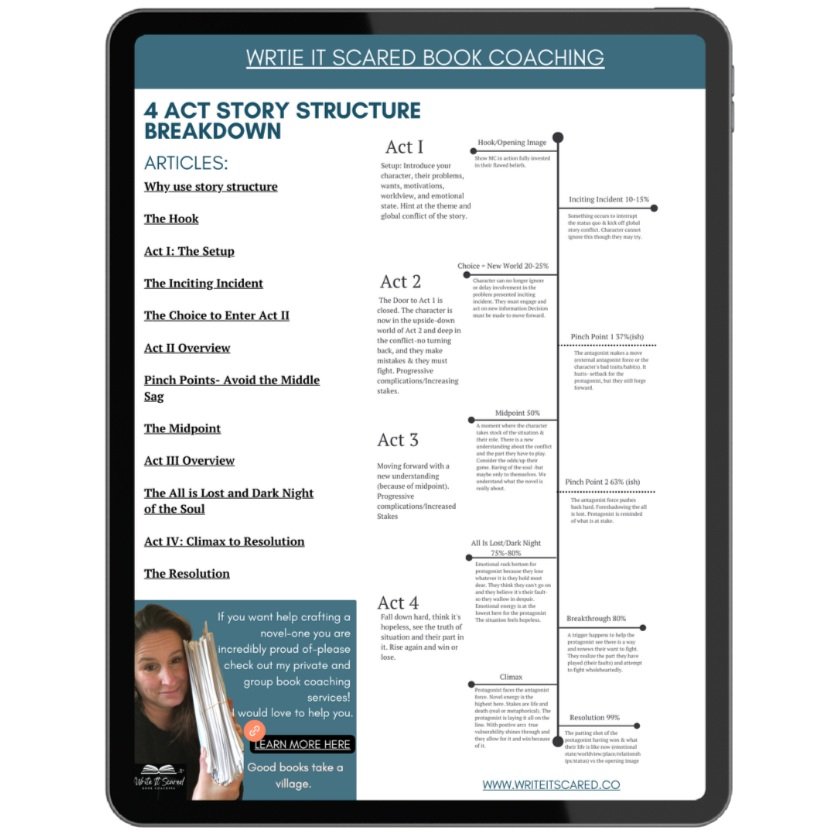How To Avoid The Saggy Middle When Writing a Novel: The Pinch Point Discussion
Deep Dive on Four-Act Story Structure Part 5 of 10
We are moving right along in our review of the Four-Act Story Structure. Here’s the PDF of the entire enchilada for reference.
The last blog article summarized the second act, which runs from the 25% mark to the 50% mark in the Four-Act story structure.
During the first part of the second act, our protagonist is bumbling about, wandering in uncharted territory, reacting to their new world but still pursuing what they think will make them happy.
If you are a Save the Cat fan, you’ll know this as the Fun and Games section, and it can be fun or not for our main character. But everything that happens must have a purpose: to drive to the story’s Midpoint, where the hot water becomes scalding.
There is a lot of ground cover, and my work with writers and my own flailing has shown me that this is part of the story where things can get repetitive, drawn out, and bogged down. To put it simply, it’s boring.
How can a writer prevent this? Cue the Pinch Point discussion.
Pinch Points are moments that remind us of what’s at stake for our protagonist by focusing on the antagonist force in the story.
Pinch points don’t get enough credit. They’re sort of buried between the inciting incident and all is lost moments of a story because they don’t change the trajectory of a story like the big plot points. Yet they serve an essential purpose: they remind the reader what the character is up against, illuminating what the story is really about.
There are two pinch points.
The first is halfway between the beginning of Act Two and the Midpoint or at the 37% mark.
The second is halfway between the Midpoint and the All is Lost moment or at the 63% mark.
What do Pinch Points do?
Well, they pinch, of course, LOL. Helpful right? Sorry, I’m not as funny as I think I am sometimes. The long and short: they make the reader worry about the main character and the global situation.
They evoke emotion and foreshadow what is to come by revealing new information about the antagonistic force, either to the character or only to the reader.
Side note: Your protagonist does not have to be present during the pinch point scene for it to do its job. Star Wars is the most classic example of a pinch point minus the protagonist: Vader uses the Death Star to blow up Alderaan. It’s not Luke who sees this. It’s Princess Leia. But we get how powerful the bad guy is here, and that’s the point.
An example of the first pinch point in an action/adventure story may be the first time the hero faces an antagonistic force in a head-on conflict.
In a romance, one of the potential love birds might get triggered by an action, a statement, or a piece of history (their own or love interests) that makes them take a step back from love.
In a character v.s. self story, it might be where the protagonist, who is in denial of their drinking problem, gets drunk on the night before a big meeting with a boss and doesn’t perform well because of it.
The second pinch point is very similar to the first, only bigger. We see an even darker, deeper, scarier side to the antagonistic force. Remember, the antagonist force can be the bad guy, a bad situation, or a bad internal trait of the protagonist.
How do you write a pinch point that works?
Here are a few tips:
Understand the antagonistic force in your story: What does it want and why? For more info- check out this article on crafting meaning conflict.
Show the muscle: Show how deep and dark the opposing force really is.
Think of how you can reveal the intention of your antagonist force that foreshadows what will come next.
It doesn’t need to be a huge moment, and your protagonist doesn’t have to be there for it (though they often are).
Next time, we will discuss the Midpoint, the pressure point we’ve been waiting for!

